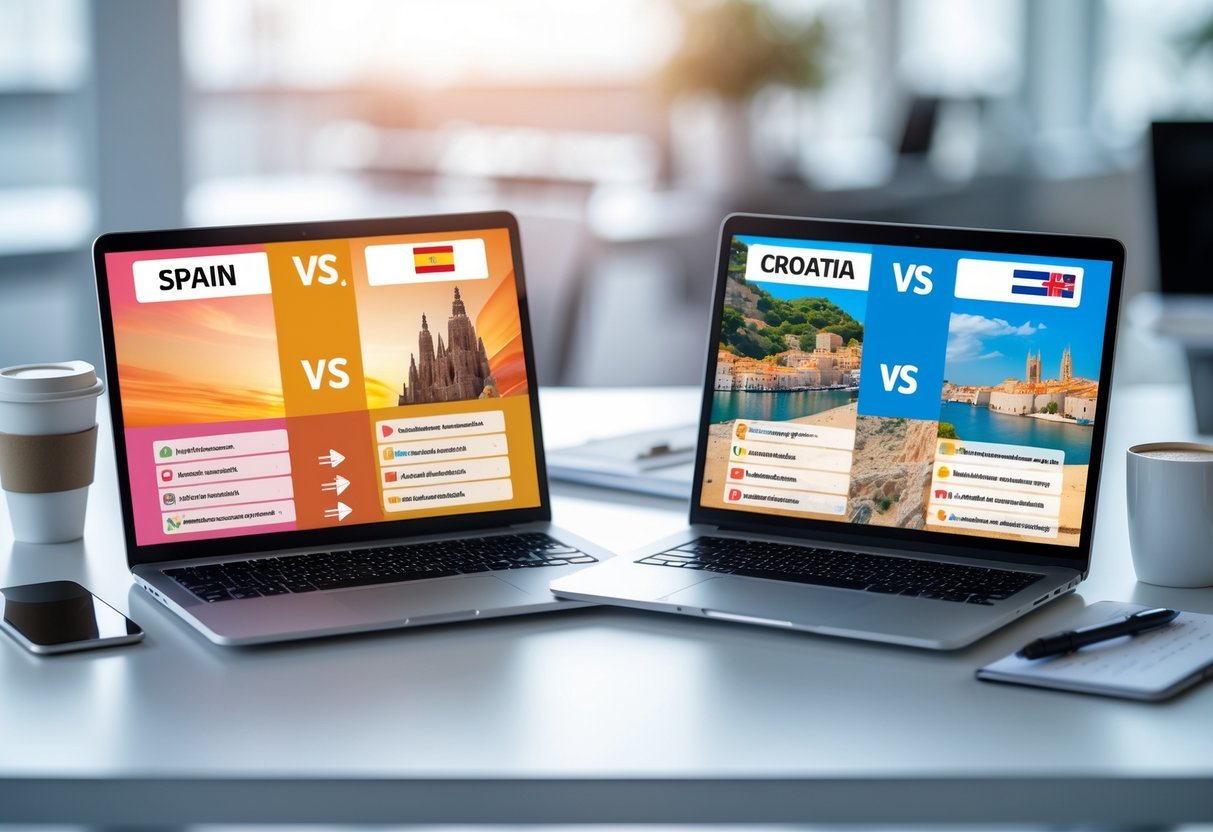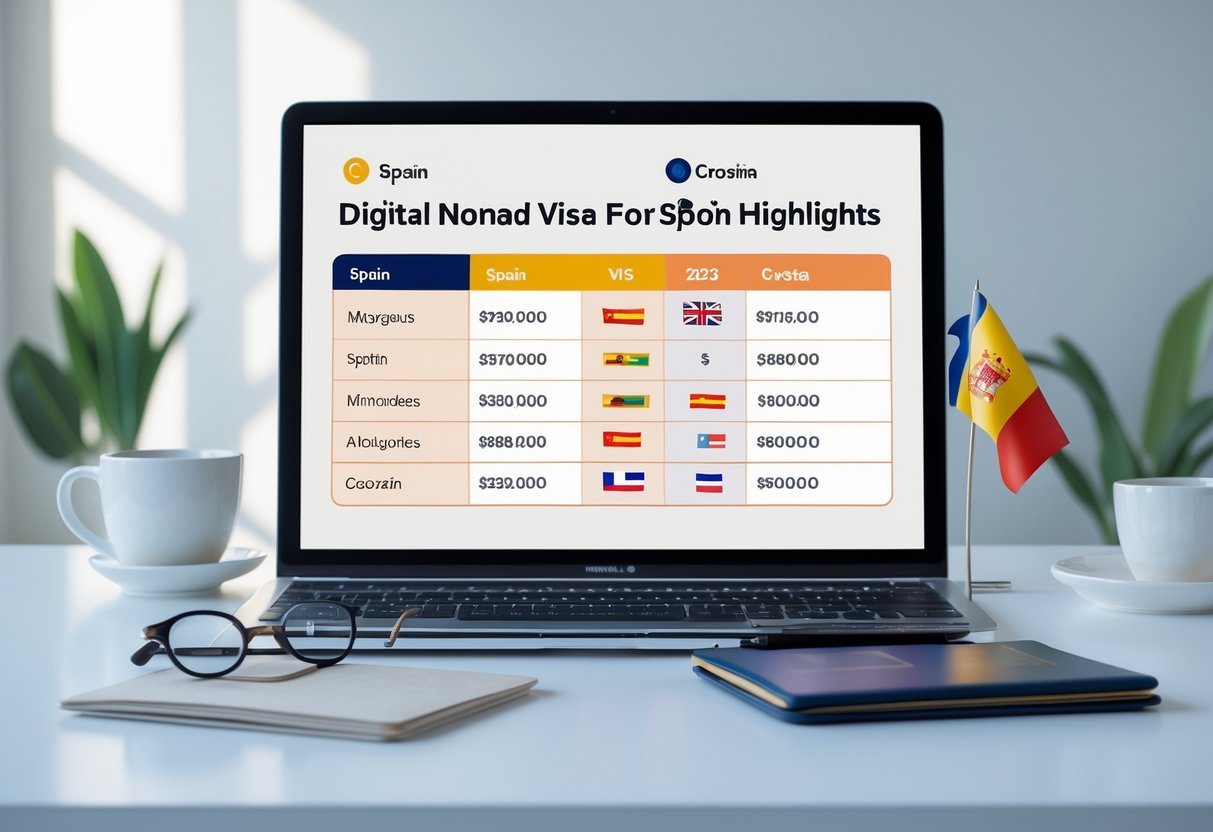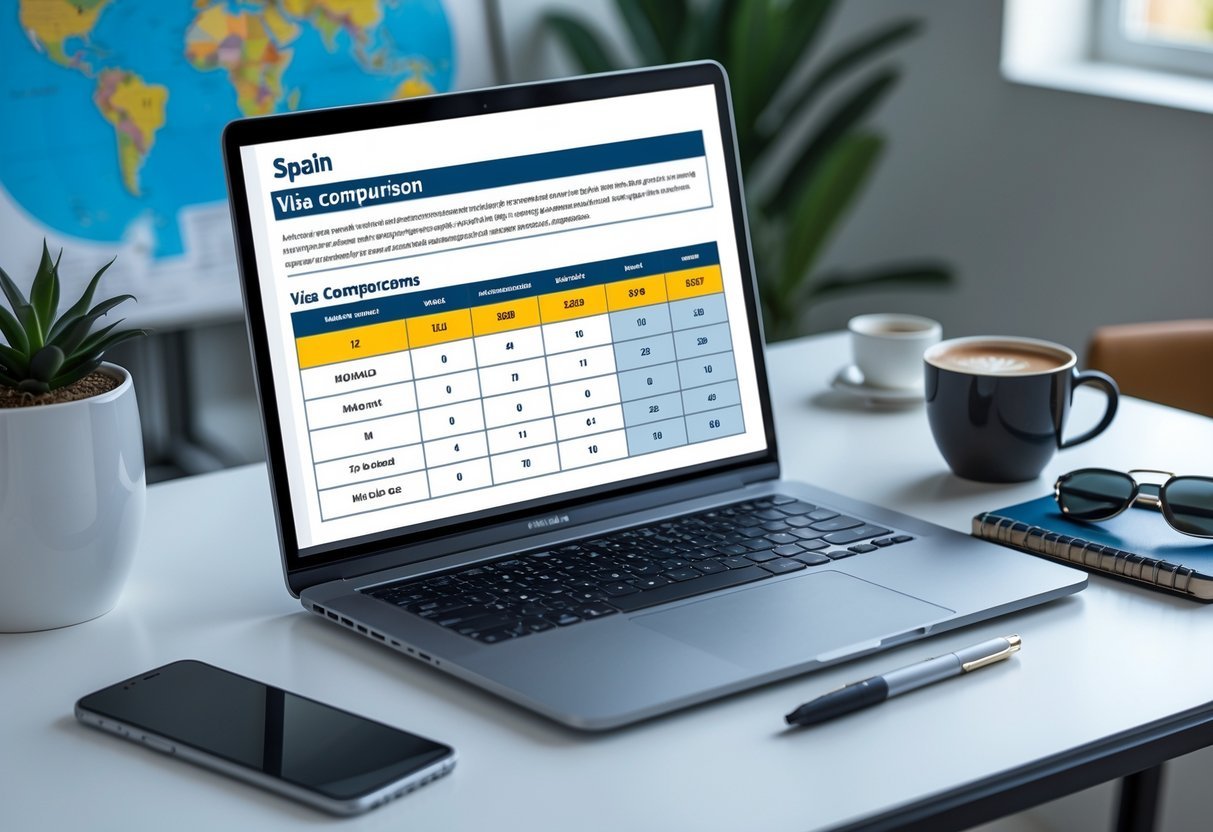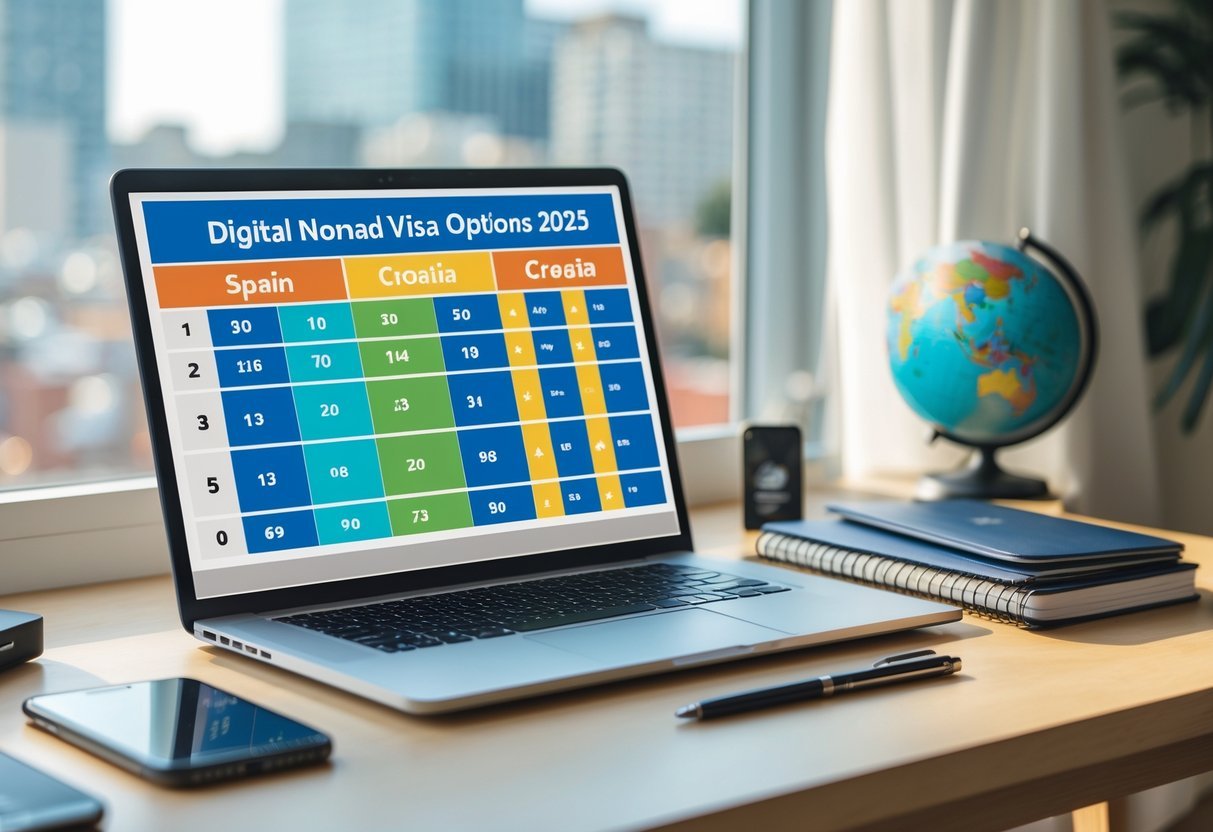If you’re hoping to work remotely from a new country, figuring out which places offer digital nomad visas really matters. Plenty of nations now have special visas that let you stay longer and work legally, skipping the headache of a traditional work permit.
This shift definitely makes the whole idea of moving abroad a lot more doable for most people.

In 2025, countries like Spain, Croatia, Thailand, and Mexico are offering digital nomad visas, each with their own quirks and requirements. The length, price, and how tricky the application is all depend on where you’re looking, so you’ll want to think about what works for your lifestyle.
The table below highlights the basics for each country’s visa. Maybe it’ll help you start dreaming about your next home base.
What Is a Digital Nomad Visa?

A digital nomad visa lets you live in a foreign country while working for an overseas employer or clients. You’ll need to follow their rules to stay on the right side of the law.
These visas come with perks like longer stays than tourist visas and easier access to local services. That’s a huge relief for anyone tired of border runs.
Definition and Purpose
Basically, a digital nomad visa is a residence permit for remote workers. It allows you to stick around without getting a local job.
The whole point is to attract people who earn online income and want to spend some quality time in a new country. It’s a win-win—nomads get fresh scenery, and countries get a little economic boost.
This visa is not the same as a tourist visa. It usually lasts much longer, sometimes a year or more.
Plus, you’re not taking local jobs, so governments tend to like the idea.
Key Eligibility Requirements
To get a digital nomad visa, you’ll almost always need to prove steady income from outside the country. The minimum can range a lot—anywhere from $2,000 to $5,000 a month, depending on where you’re headed.
You’ll also need health insurance that works in your new country. A clean criminal record and a valid passport are pretty much always required.
Some places want to see your accommodation details or a work plan. The specifics can get weirdly detailed, so check early.
Benefits for Remote Workers
With a digital nomad visa, you can actually live somewhere for a year or longer. Forget about hopping out every 90 days just to reset your tourist stamp.
You’ll usually find it’s easier to get local banking, SIM cards, and other essentials. Some countries even throw in tax perks or less paperwork than normal work visas.
Above all, you’re not constantly stressing about breaking immigration rules while you work.
Countries Offering Digital Nomad Visas in 2025

There’s a surprising variety of digital nomad visas out there. Each country has its own spin—some focus on low taxes, others on easy paperwork or longer stays.
Here are a few of the most popular choices for 2025, just to get your wheels turning.
Spain
Spain gives you a digital nomad visa for up to a year, and you can renew it for as long as five years. You’ll need to show at least €2,000 a month in income.
It’s valid everywhere in Spain, islands included. Living costs run from about €1,200 to €2,000 monthly, depending on where you settle.
Health insurance is a must, and you’ll need to register locally within three months. With this visa, you can also bounce around the Schengen Area pretty freely.
Croatia
Croatia’s visa lasts a year, but you can’t extend it. The income requirement is about €2,200 per month, and you can’t take a local job—just remote work for non-Croatian companies.
The coastlines are gorgeous, and expenses are usually lower than in Western Europe. Health insurance and a clean record are required, and you’ll need to register with the police within 48 hours of arrival.
You’re free to travel around Croatia as much as you want.
Thailand
Thailand launched its digital nomad visa in 2024. It lets you stay up to two years, as long as you can prove a $2,500 monthly income or $40,000 in savings.
Health insurance covering $100,000 in medical expenses is required. Living is cheap, the culture’s lively, and the Wi-Fi’s fast.
You can’t take a Thai job, but remote work is fine. Expect background checks and a health exam during the process. If you keep meeting the requirements, you can renew.
Mexico
Mexico offers a digital nomad visa for a year, with possible extensions up to three years. You’ll need to prove about $1,620 in monthly income or $27,000 in savings over the last year.
You can work from anywhere in Mexico—city, beach, mountains, you name it. Health insurance is suggested but not strictly required.
Registration with immigration is needed within 30 days of arrival. Mexico doesn’t really care what kind of remote work you do.
Portugal
Portugal’s digital nomad visa is good for a year and can be renewed up to five years. You’ll need to show at least €2,800 a month in income or proof of savings.
Lisbon and Porto are favorites for nomads, thanks to solid infrastructure and a great vibe. Health insurance is required, and you’ll need to register locally.
The visa also lets you travel across the Schengen zone with no extra hassle.
Estonia
Estonia was actually one of the first to roll out a digital nomad visa. It’s valid for up to a year, and you’ll need to prove a monthly income of €3,500 (or the equivalent for the last six months).
Estonia is big on digital services and easy online applications. The startup culture is strong, internet is quick, and living costs aren’t too wild.
Health insurance is required, and you can travel around the Schengen Area with this visa.
Greece
Greece’s digital nomad visa lets you stay up to a year, with the option to extend to two years. You’ll need €3,500 a month in income and health insurance.
Life here is relaxed and affordable, especially if you skip Athens. You can apply at a consulate or online, and once you’re approved, register locally.
Greece is packed with beautiful spots to work from—hard to complain about the scenery.
Comparison Table: Digital Nomad Visa Highlights by Country

Picking the right digital nomad visa? It helps to look at the basics: how long you can stay, how much you need to earn, and what it’ll cost you up front.
Here’s a quick table with Spain, Croatia, Thailand, and Mexico for 2025. Maybe it’ll save you a few hours of Googling.
| Country | Visa Length | Income Requirement | Application Fee | Key Notes |
|---|---|---|---|---|
| Spain | Up to 1 year | Around €2,000/month | €80 – €100 | Health insurance needed |
| Croatia | Up to 1 year | Around €2,200/month | About €100 | Must prove remote work |
| Thailand | Up to 2 years | Around $2,500/month | $100 – $150 | Requires health insurance |
| Mexico | Up to 1 year (temporary resident) | Around $1,620/month | $36 – $50 | Can extend or change to permanent |
You’ll almost always need proof of income and health insurance. Each country defines “remote work” a little differently, and some make renewals easier than others.
Check the application process ahead of time. Some places want more paperwork or even an in-person visit, so don’t leave it till the last minute.
Popular Digital Nomad Visa Requirements

Every country sets its own digital nomad visa rules, but you’ll usually need to prove you earn enough, show you’re covered by health insurance, and document that you’re working remotely. The details can get a little nitpicky.
Income Thresholds
Most digital nomad visas want to see a minimum monthly income. It’s usually somewhere between $1,500 and $3,000, but the numbers jump around.
Spain sits at about €2,000, while Thailand is closer to $1,500. Bank statements, payslips, or even freelance contracts can work as proof.
Without hitting that income mark, you’re probably not getting approved. It’s their way of making sure you won’t need a local job.
Health Insurance Policies
Health insurance is non-negotiable for most digital nomad visas. You’ll need a plan that covers medical emergencies and hospital stays, sometimes even repatriation.
Some countries insist on local providers, others are fine with international insurance. Mexico is fairly chill—basic travel insurance is okay—while Croatia wants something more comprehensive.
Double-check that your policy fits the visa requirements, or you might get tripped up at the last minute.
Remote Employment Proof
You’ll have to show you work remotely for a foreign company or run a freelance gig outside your new host country. Typical documents include contracts, invoices, or a letter from your boss.
Some places want a letter confirming your job and business location. Others ask for tax returns or proof of regular payments. The idea is to make sure you’re not competing for local jobs.
Application Process for Digital Nomad Visas

Applying for a digital nomad visa means paperwork, deadlines, and a bit of patience. If you know what to prepare and how long it’ll take, you’ll have a smoother ride.
Key Documents Needed
Here’s what you’ll usually need to pull together for your application:
- A valid passport (with at least six months left on it)
- Proof of income or remote work—bank statements, contracts, or similar
- Health insurance that’s good in your destination country
- A clean criminal record certificate from home
- Completed application forms and some recent passport photos
Some countries might ask for extras like a cover letter or proof of where you’ll stay. Always double-check the list for your chosen country—requirements change, and you don’t want surprises.
Application Timeline
The time it takes to get your visa usually varies from 2 weeks to 3 months.
Countries like Croatia and Mexico tend to process applications faster, often within 2-4 weeks.
Spain and Thailand can take longer, sometimes up to 8-12 weeks depending on the season and workload at the visa office.
Applying early and submitting all required documents helps avoid delays.
Keep in mind some countries might require in-person interviews or appointments, which can add time.
Tips for a Successful Application
Start by making sure your documents are complete and originals or certified copies are provided.
Double-check all forms for accuracy and signatures. Incomplete or incorrect forms are a common reason for rejection.
Show clear proof of stable income; many countries set minimum monthly amounts between $1,500 and $3,000.
Having health insurance that covers COVID-19 and other medical needs is often mandatory.
Keep copies of everything and follow the embassy’s updates during processing.
Considerations Before Choosing a Digital Nomad Destination

When picking a country for your digital nomad visa, you should focus on how much things cost, how good the internet is, and how local taxes might affect you.
These factors will shape your daily life, work, and finances. It’s a lot to weigh, honestly.
Cost of Living and Lifestyle
Before moving, check how much basic expenses like rent, food, and transport will cost you.
For example, Mexico has a lower cost for groceries and housing compared to Spain.
But lifestyle matters too—some places offer vibrant city life, while others are quieter and more relaxed.
Think about what you want from your free time. Beaches in Thailand might suit you if you prefer a laid-back vibe.
Cities like Zagreb in Croatia offer a mix of culture and nightlife. Make sure your budget matches the lifestyle you want.
Internet Connectivity and Infrastructure
Reliable internet is crucial. Spain and Thailand typically offer fast and steady connectivity in urban areas.
Croatia and Mexico can vary widely depending on location, with some rural spots having slower or unstable service.
Also, consider workspace options. Co-working spaces and cafes with Wi-Fi can be important.
In bigger cities, these are more common and better maintained, while rural areas might lack them.
Local Tax Implications
You should know how local taxes affect your income. Some countries tax your worldwide earnings, while others only care about what you make locally.
Spain, for example, taxes residents on global income. That can really bump up your tax bill if you’re not careful.
Find out if you’ll need to file extra paperwork or deal with social security taxes. Some digital nomad visas toss in tax exemptions or lower rates, but the fine print matters—double-check before you leap.





[…] stays often require planning beyond normal tourism. Research visa requirements for longer visits. Some countries offer special visas for digital nomads or extended tourism […]